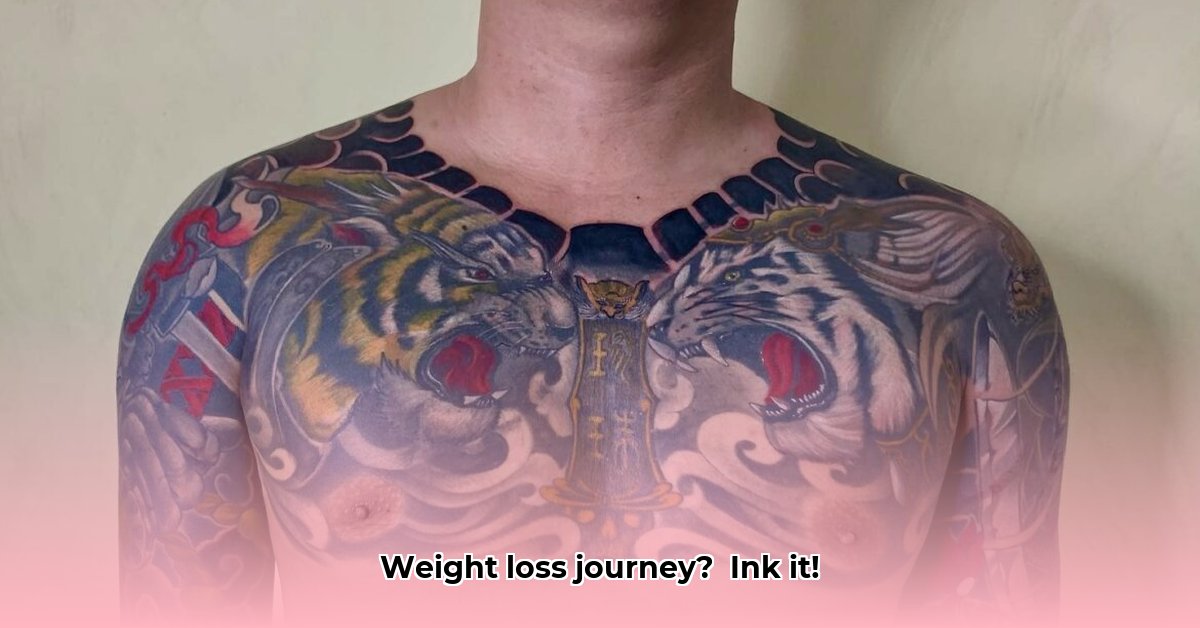
Reaching your weight loss goals is a monumental achievement, a testament to your dedication and strength. For many, it's a transformative journey deserving of a lasting celebration. A weight loss tattoo offers a powerful and personal way to commemorate this incredible milestone – a permanent reminder of your hard work and self-love. But before you take the plunge, let's explore this significant decision thoughtfully.
Designing Your Triumph: Finding the Perfect Symbol
What does your weight loss journey mean to you? Is it a symbol of resilience, newfound strength, or self-acceptance? Your tattoo should authentically reflect your unique story. Consider these ideas:
- Meaningful Symbols: Images representing change and growth—a phoenix rising, a blooming flower, or balancing scales—beautifully capture the essence of your transformation. What image symbolizes your personal journey best?
- Motivational Words: A short, powerful quote—something deeply resonant—can serve as daily inspiration. Keep it concise and impactful.
- Abstract Art: For a unique approach, abstract art can capture the feeling of your journey, allowing for complete personal expression.
- Before & After (with caveats): A bolder choice, visually documenting your progress. However, significant future weight changes might alter its appearance. We'll discuss this further below.
Placement is crucial. Consider areas less prone to significant stretching or shape changes with future weight fluctuations, such as your upper back, ribs, or collarbone. Let's delve into placement options in more detail later.
Finding Your Perfect Artist: A Partnership in Art
This is permanent art, so choosing the right artist is paramount. Treat this like selecting a skilled surgeon for a delicate procedure – research is key.
- Research & Portfolio Review: Search for artists specializing in fine detail, realistic designs (if desired), or the style you prefer, examining their portfolios thoroughly. Does their style align with your vision?
- Consultation is Crucial: Schedule a consultation to discuss ideas, placement, and any questions. Don't hesitate to ask!
- Verify Their Reputation: Check online reviews and ask for references to gauge professionalism and skill. Word-of-mouth is invaluable.
Preparing for Your Tattoo Appointment: A Checklist for Success
Proper preparation ensures optimal results and comfort. Here's your pre-tattoo checklist:
- Skin Health: Ensure your skin is healthy, clean, and free from irritations or sunburns.
- Hydration: Drink plenty of water in the days leading up to your appointment. Hydrated skin heals better.
- Rest: Get sufficient sleep to minimize discomfort and maximize comfort during the procedure.
- Nourishment: Have a light meal beforehand to avoid lightheadedness.
Aftercare and Long-Term Care: Preserving Your Masterpiece
Proper aftercare is essential for healing and longevity. Follow your artist's instructions meticulously; they're the experts. Keep your tattoo moisturized to maintain vibrancy and prevent fading.
Significant weight changes can impact your tattoo's appearance. Weight loss or gain might lead to stretching or distortion. While touch-ups are possible, they're not always perfect. Let’s discuss managing expectations.
Weighing the Pros and Cons: A Realistic Perspective
| Advantages | Potential Drawbacks |
|---|---|
| Permanent reminder of your journey | Significant weight changes may cause distortion. |
| Powerful symbol of self-love and strength | It's a permanent decision; take your time and be certain. |
| Ongoing inspiration and motivation | Requires diligent aftercare to maintain its appearance. |
| Unique expression of transformation | There's a small chance of future regret; ensure it's the right choice |
How to Choose a Design That Minimizes Distortion After Weight Fluctuation
Significant weight changes directly affect tattoo appearance, with larger fluctuations causing more noticeable distortion. Placement is critical; areas prone to stretching (abdomen, thighs) risk alteration. Smaller, simpler designs generally hold up better. Consultation with a skilled tattoo artist is essential for advice on design and placement. Maintaining a healthy weight range and proper skin care minimizes distortion.
Understanding the Impact of Weight Change
Imagine your skin as a canvas. Weight loss or gain stretches or shrinks this canvas, affecting your tattoo. The degree of alteration depends on the amount of weight change, tattoo size and placement, and skin elasticity.
Design and Placement Strategies
- Smaller Designs: Opt for smaller, simpler designs; intricate details blur with weight changes.
- Strategic Placement: Choose areas less affected by weight fluctuations: upper arms, shoulders, back, or feet.
- Style Considerations: Solid lines and bold shapes hold their form better than highly detailed designs. Minimalist or watercolor styles are generally more resilient.
- Expert Consultation: Consult a reputable tattoo artist experienced in this area. They can advise on choices minimizing distortion.
Artist Selection and Aftercare: Long-Term Considerations
Choosing the right artist is crucial. Select someone with a strong portfolio and a reputation for excellent, long-lasting work. Ask to see examples of their work that has aged well. Proper aftercare (moisturizing, sun protection, following your artist's instructions) is paramount. While you can't eliminate all risks, proper aftercare minimizes the impact of potential distortion.
Long-Term Planning and Maintenance
Even after achieving your goals, weight may still fluctuate slightly. Regular skin care, including consistent moisturizing, helps maintain collagen and elastin, improving skin elasticity and mitigating some distortion effects. Remember, this is a long-term commitment.